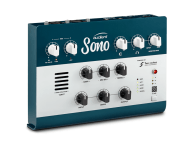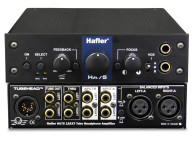
“We first showed the Space Heater over a year ago and anticipated delivery mid-way in 2014. As we got closer to production, we discovered anomalies with tubes that were beyond our control. This forced us to pull back the product and redesign the circuitry to accommodate. To understand the problem you have to start by understanding the Space Heater’s circuit. 12AX7 tubes have two filaments inside that enable us to drive two channels using a single tube. The original design was configured with a single input and output control for each channel pair or each tube. During beta tests, we discovered that the output from each side of the tube can vary significantly depending on the filament. And although the user could perform gain make-ups in a workstation or via a recording desk, we felt that having individual inputs and outputs for all eight channels would be a much smarter option. This of course sent the design back to R&D where the circuit was redesigned and new dual concentric potentiometers had to be custom made to suit,” explains Radial’s President, Peter Janis.

Designed as a character box, the Radial Space Heater packs eight tube channels into a compact, single 19” space with individual drive and output for each channel. The design begins with eight +4 dBu balanced line level inputs that feed four 12AX7 tubes wired in stereo. A three-position "HEAT" switch enables the user to switch from 35, 70, or 140 V to dial-in a touch of distortion or go over the top with full saturation.
Each of the eight outputs is equipped with an oversized output transformer for beefy character while providing galvanic isolation to eliminate noise. Its also possible to bypass the tube circuit and drive the transformer on its own to produce a vintage feel that is reminiscent of the finest audio designs from yesteryears.
 Each channel may be used individually or all eight channels may be mixed to a stereo bus. This, for example, could be used to fatten up the sound of a drum kit. A built-in headphone amp is available for monitoring or trouble shooting. Connections to and from the Space Heater are supported with both balanced ¼” TRS and 25-pin D-subs along with XLRs at the master output.
Each channel may be used individually or all eight channels may be mixed to a stereo bus. This, for example, could be used to fatten up the sound of a drum kit. A built-in headphone amp is available for monitoring or trouble shooting. Connections to and from the Space Heater are supported with both balanced ¼” TRS and 25-pin D-subs along with XLRs at the master output.The send jacks or the D-subs can be used to process individual instruments. Used as four stereo pairs, the Space Heater can be used to fatten stereo stems and all eight channels can be sent to the master left-right XLR outputs for stereo summing with odd channels routed left and even channels routed right. This set up is often used to add crunch to drum kits or for traditional analog (out-of-the-box) summing and can be expanded using the link connectors for 16, 24, or 32 x2 summing requirements. This is supplemented with high-pass filters on each channel that help clean up tracks by removing excessive low frequency resonance.
Janis continues: “Distortion is often thought of as an effect as made famous by acts as diverse as the Beatles and Nine Inch Nails. But what few realize is that distortion can also be used in a very subtle way to add character to a vocal track or accentuate a bass giving it more presence without increasing the level. It also has tremendous appeal for live performers who employ in-ear monitors. The Space Heater can be set to act like a natural limiter by clipping transients which in turn will make in-ear monitors sound more natural.”
MAP for the Space Heater is $1,699.99 USD.
www.radialeng.com/spaceheater.php






